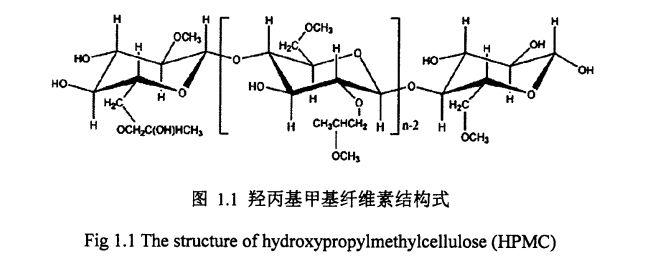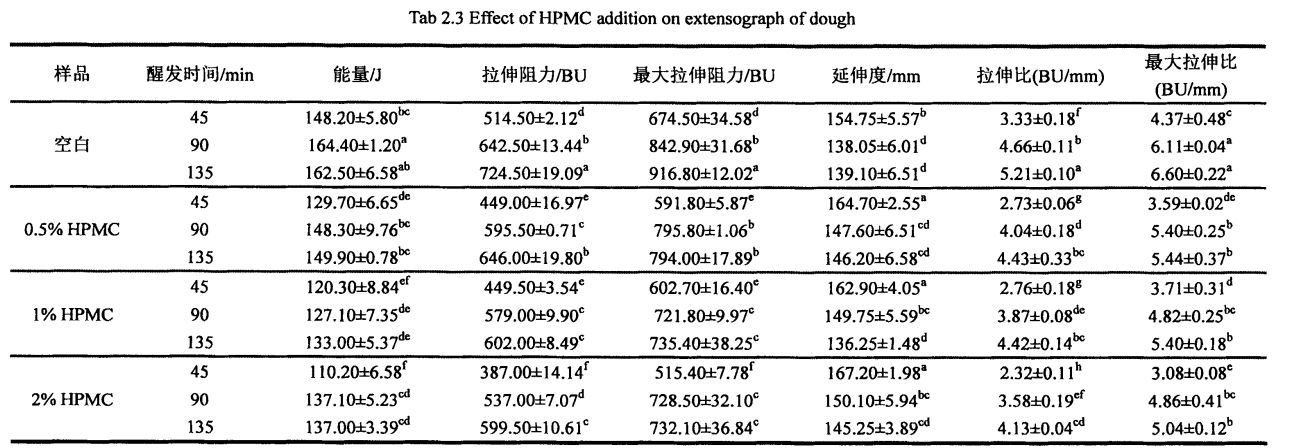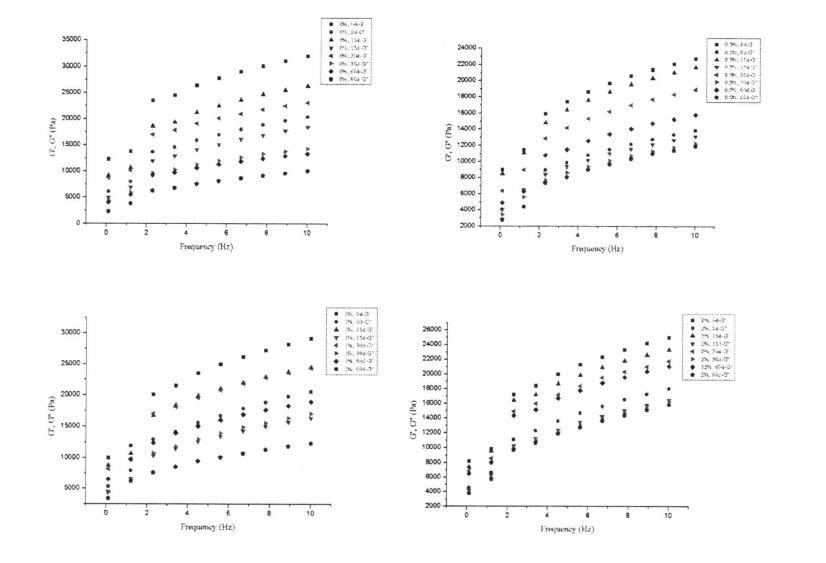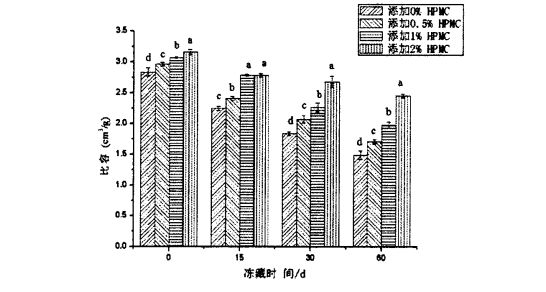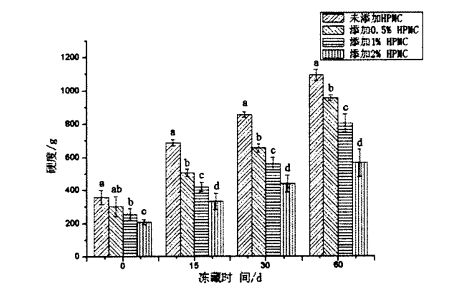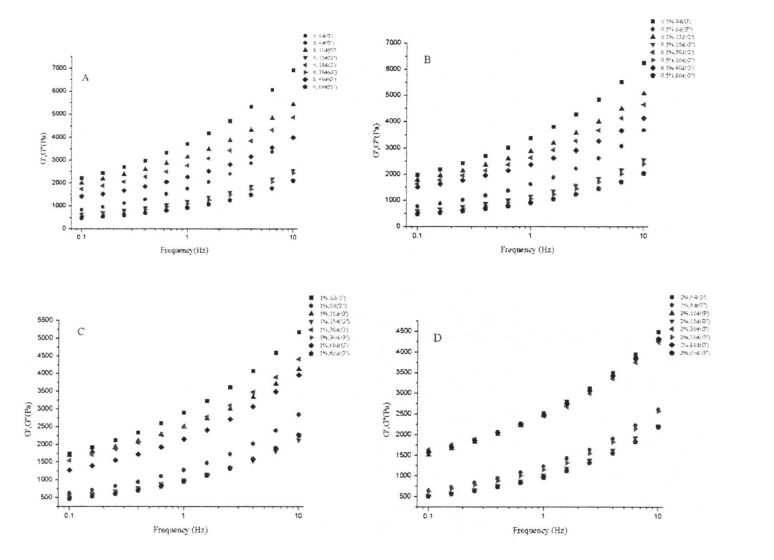खमीर को फेयर ग्यास उत्पादन गतिविधि छ कि कृषित पीठो उत्पादन को गुणवत्ता मा एक महत्वपूर्ण प्रभाव छ। Through experiments, it was found that, compared with the control group, the addition of HPMC could better maintain the fermentation activity of yeast and reduce the increase rate of extracellular reduced glutathione content after 60 days of freezing, and within a certain range, The protective effect of HPMC was positively correlated with its addition amount.
1.1.7 Hydroxyprplyploply Metly सेल्युलोज (हाइड्रोक्स्ट्रोफ्रोपल सेलपल सेल्युलोज, I-IPMC) .......... W
2.3 Experimental results and discussion…………………………………………………………………… . 11
2.3.4 The effect of HPMC addition and freezing time on the rheological properties of dough…………………………. .......................9। [Ntevew
3.2.4 Experimental methods ....................................................................................................... 2.
3.3.2.2 ESPMC र फ्रिजेशनशील ओसिलो सामग्री (CFW) र थर्मल स्थिरताका लागि फ्रिजिंग भण्डारण समय थप्ने प्रभावको प्रभाव। ....................... 0वटा
3.3..3 प्रभाव HPMC थप रकम र नि: शुल्क सॉल्डिड्रिल सामग्री (C VESEL) मा फ्रिजिंग भण्डारण समय ................................ . ? 34
4.1 Introduction .............................................................................................................................. . ? 44
2.2 प्रयोगात्मक सामग्री र विधिहरू ............................................... The
4.3 Analysis and discussion ........................................................................................................... ? 48
4.3.1 गहुँ स्टार्चको आधारभूत कम्पोनेन्टहरूको सामग्री ................................ ........ ? 48
4.3.3 Effects of HPMC addition and freezing storage time on the shear viscosity of starch paste………………………………………………………………………………………………………………………………………. कार्य 62
4.3.6 Effects of I-IPMC addition amount and frozen storage time on the thermodynamic properties of starch ………………………………………………………………………………………………………. . A7
5.1Introduction .................................................................................................................................... A2
.2.2 सामग्री र विधिहरू ...............................................। A2
2.2.1 प्रयोगात्मक सामग्री र उपकरणहरू ................................................ 62। 62
5.2.2 Experimental methods . । । । । ............................... "................ A3 तब The
8..3 परिणाम र छलफल ...............................। A 64
5.3.3 The effect of adding amount of HPMC and freezing time on the content of glutathione in dough……………………………………………………………………………………………………………66. "
5.4 Chapter Summary ........................................................................................................................ The
अध्याय 9 निष्कर्ष र संभावना।
6.1 Conclusion ................................................................................................................................. . The
6.2 Outlook .......................................................................................................................................... The
चित्रणहरूको सूची
फिगर 1.1 हाइड्रोक्स्ट्रोपलफ्लि kslylyclise को संरचनात्मक सूत्र ........................ . The
चित्र 2.3 HPMC थप र स्टीम्ड रोटीको कठोरतामा हिजेको प्रभाव ................................ ... ... ...।
Figure 2.4 The effect of HPMC addition and freezing time on the elasticity of steamed bread………………………………………………………………………………………………………………………………. . राष्ट
Figure 3.1 The effect of HPMC addition and freezing time on the rheological properties of wet gluten…………………………………………………………………………………………………………………………. 0वटा
Figure 3.2 Effects of HPMC addition and freezing time on the thermodynamic properties of wheat gluten………………………………………………………………………………………………………………. . ? 34
फिगर 3..3 प्रभाव HPMC थप र गहुँ ग्लेटको नि: शुल्क सॉल्हारिल सामग्रीमा फ्रिज गर्ने समय ............................... ...। 35
चित्र 6.6 दृष्टान्त ................................ ........39
Figure 3.7 The effect of HPMC addition and freezing time on the microscopic gluten network structure…………………………………………………………………………………………………………... . The 43
Figure 4.1 Starch gelatinization characteristic curve ............................................................... Ande1
Figure 4.2 Fluid thixotropy of starch paste ................................................................................. कार्य 62
Figure 4.3 Effects of adding amount of MC and freezing time on the viscoelasticity of starch paste……………………………………………………………………………………………………………………... . A7
Figure 4.5 Effects of HPMC addition and freezing storage time on the thermodynamic properties of starch…………………………………………………………………………………………………………. . Acture
Figure 5.2 The effect of HPMC addition and freezing time on the yeast survival rate…………………………………………………………………………………………………………………………………... . The
Figure 5.3 Microscopic observation of yeast (microscopic examination) …………………………………………………………………………………………………………………………. The
Table 2.1 The basic ingredient content of wheat flour…………………………………………………. 11
Table 3.2 Effects of I-IPMC addition amount and freezing storage time on the phase transition enthalpy (Yi IV) and freezer water content (e chat) of wet gluten………………………. ?1
Table 3.3 Effects of HPMC addition amount and freezing storage time on the peak temperature (product) of thermal denaturation of wheat gluten…………………………………………. अवस्थामा 3 33
Table 3.6 Effects of I-IPMC addition and freezing storage time on the surface hydrophobicity of wheat gluten……………………………………………………………………………………………. A1
Table 4.3 Effects of I-IPMC addition and freezing time on the shear viscosity of wheat starch paste…………………………………………………………………………………………………………………………. ?5
1)Development of new characteristic steamed buns. Through the innovation of steamed bread raw materials and the addition of functional active substances, new varieties of steamed breads have been developed, which have both nutrition and function. Established the evaluation standard for the quality of miscellaneous grain steamed bread by principal component analysis; Fu et a1. (2015) added lemon pomace containing dietary fiber and polyphenols to steamed bread, and evaluated the antioxidant activity of steamed bread; Hao & Beta (2012) studied barley bran and flaxseed (rich in bioactive substances) The production process of steamed bread [5]; Shiau et a1. (201)) आटा शेलोजिकल गुणहरू र उमालेको रोटीको क्वालिटी []] मा अनानास स्ल्याब फाइब फाइब फाइब फाइब फाइब फाइब फाइब गर्नुहोस्।
2)Research on the processing and compounding of special flour for steamed bread. The effect of flour properties on the quality of dough and steamed buns and the research on new special flour for steamed buns, and based on this, an evaluation model of flour processing suitability was established [7]; for example, the effects of different flour milling methods on the quality of flour and steamed buns[7] 81; The effect of the compounding of several waxy wheat flours on the quality of steamed bread [9J et al.; Zhu, Huang, &Khan (2001) evaluated the effect of wheat protein on the quality of dough and northern steamed bread, and considered that gliadin/ Glutenin was significantly negatively correlated with dough properties and steamed bread quality [lo]; Zhang, et A1। (2007) analyzed the correlation between gluten protein content, protein type, dough properties and steamed bread quality, and concluded that the content of high molecular weight glutenin subunit (1ligh.molecular-weight, HMW) and total protein content are all related to the quality of northern steamed bread. have a significant impact [11].
Most studies have found that the formation and growth of ice crystals in frozen foods is an important factor leading to the deterioration of product quality [291]. Ice crystals not only reduce the survival rate of yeast, but also weaken the gluten strength, affect the starch crystallinity and gel structure, and damage the yeast cells and release the reducing glutathione, which further reduces the gas holding capacity of gluten. In addition, in the case of frozen storage, temperature fluctuations can cause ice crystals to grow due to recrystallization [30]. Therefore, how to control the adverse effects of ice crystal formation and growth on starch, gluten and yeast is the key to solving the above problems, and it is also a hot research field and direction. पछिल्ला दश बर्षमा धेरै अन्वेषकहरू यस काममा संलग्न छन् र केही फलदायी अनुसन्धान परिणामहरू प्राप्त गरे। यद्यपि यस फिल्डमा अझै केही खाली ठाउँहरू र केही नबहछका लागि लगाएका छन् र केहि अन्वेषण गर्नु आवश्यक छ, जस्तै:
Studies have shown that the main reasons for the deterioration of the processing properties of frozen dough include: 1) During the freezing process, the survival of yeast and its fermentation activity are significantly reduced; 2) The continuous and complete network structure of the dough is destroyed, resulting in the air holding capacity of the dough. र संरचनात्मक शक्ति ठूलो मात्रामा कम हुन्छ।
Ii। Optimization of frozen dough production process, frozen storage conditions and formula. During the production of frozen dough, temperature control, proofing conditions, pre-freezing treatment, freezing rate, freezing conditions, moisture content, gluten protein content, and thawing methods will all affect the processing properties of frozen dough [37]. In general, higher freezing rates produce ice crystals that are smaller in size and more uniformly distributed, while lower freezing rates produce larger ice crystals that are not uniformly distributed. In addition, a lower freezing temperature even below the glass transition temperature (CTA) can effectively maintain its quality, but the cost is higher, and the actual production and cold chain transportation temperatures are usually small. In addition, the fluctuation of the freezing temperature will cause recrystallization, which will affect the quality of the dough.
III। Using additives to improve the product quality of frozen dough. In order to improve the product quality of frozen dough, many researchers have made explorations from different perspectives, for example, improving the low temperature tolerance of material components in frozen dough, using additives to maintain the stability of the dough network structure [45.56], etc. Among them, the use of additives is an effective and widely used method. Mainly include, i) enzyme preparations, such as, transglutaminase, O [. Amylase; ii) emulsifiers, such as monoglyceride stearate, DATEM, SSL, CSL, DATEM, etc.; iii) antioxidants, ascorbic acid, etc.; iv) polysaccharide hydrocolloids, such as guar gum, yellow Originalgum, gum Arabic, konjac gum, sodium alginate, etc.; v) other functional substances, such as Xu, et a1. (2009) added Ice-structuring Proteins to wet gluten mass under freezing conditions, and studied its protective effect and mechanism on the structure and function of gluten protein [y71.
The chemical nature of hydrocolloid is a polysaccharide, which is composed of monosaccharides (glucose, rhamnose, arabinose, mannose, etc.) through 0 [. 1-4. Glycosidic bond or/and a. 1 - "। Gllcosidic बन्ड वा बी 1-- g glercosidic बन्धन र 0 [.1 [.1 ① को लागी एक धनी विविधता को लागी: जस्तै MEMBLOLLISLE जैविक सेल्युम्बल छ। ② बोट polysaccharides, such as konjac gum, guar gum, gum Arabic ; ③ seaweed polysaccharides, such as seaweed gum, carrageenan; ④ microbial polysaccharides, such as Xanthan gum .Polysaccharide has strong hydrophilicity because it contains a large number of hydroxyl groups that are easy to form hydrogen bonds with water, and has the functions of controlling the migration, state and distribution of water in the food system. Therefore, the addition of hydrophilic colloids gives food Many functions, properties, and qualities of hydrocolloids are closely related to the interaction between polysaccharides and water and other macromolecular substances. At the same time, due to the multiple functions of thickening, stabilizing, and water retention, hydrocolloids are widely used to include in the food processing of flour products. Wang Xin et al. (2007) studied the effect of adding seaweed polysaccharides and gelatin on the glass transition temperature of dough [631. Wang Yusheng et al. (2013) believed that compound addition of a variety of hydrophilic colloids can significantly change the flow of dough. Change the properties, improve the tensile strength of the dough, enhance the elasticity of the dough, but reduce the extensibility of the dough [delete.
Due to the existence of hydrogen bonds in the linear molecular chain and crystalline structure, cellulose has poor water solubility, which also limits its application range. जे होस्, एचपीएमसीको पक्ष श्रृंखलामा प्रतिस्थापनहरूको उपस्थिति इन्ट्राल्फरोलिल हाइड्रोजन बन्धन तोड्यो, यसलाई अधिक जलविद्युत [69 65 ell] बनाउँदछ, जुन पानीमा ढल्कँदै जान्छ र स्थिर तापक्रम टाईमा। As a cellulose derivative-based hydrophilic colloid, HPMC has been widely used in the fields of materials, papermaking, textiles, cosmetics, pharmaceuticals and food [6 71]. In particular, due to its unique reversible thermo-gelling properties, HPMC is often used as a capsule component for controlled release drugs; in food, HPMC is also used as a surfactant, Thickeners, emulsifiers, stabilizers, etc., and play a role in improving the quality of related products and realizing specific functions. For example, the addition of HPMC can change the gelatinization characteristics of starch and reduce the gel strength of starch paste. , HPMC can reduce the loss of moisture in food, reduce the hardness of bread core, and effectively inhibit the aging of bread.
ठ्याक्कै पनि ठ्याक्कै छ कि चिनियाँ चाउचाउमा एचपीएमसीको प्रासंगिक आवेदक अझै पनि तुलनात्मक रूपमा अभाव छ। Therefore, the purpose of this experiment is to expand the application of HPMC to frozen dough, and to determine the improvement of frozen dough processing by HPMC through the evaluation of steamed bread quality. In addition, HPMC was added to the three main components of the dough (wheat protein, starch and yeast liquid), and the effect of HPMC on the structure and properties of wheat protein, starch and yeast was systematically studied. And explain its related mechanism problems, in order to provide a new feasible path for the quality improvement of frozen dough, so as to expand the application scope of HPMC in the food field, and to provide theoretical support for the actual production of frozen dough suitable for making steamed bread.
1.3 अध्ययनको मुख्य सामग्री
TX-xt प्लस शारीरिक सम्पत्ती परीक्षक
C21। Kt2134 प्रेशन कुकर
Powder meter. B
Extensometer. B
SX2..4.10 Muchle भट्टी
उत्पादक
अमेरिकी टी कम्पनी
अमेरिकी टी कम्पनी
सम्बन्धित जाडोको समय पछि पाठो नमूनाहरू निकाल्नुहोस्, तिनीहरूलाई 4 ° C मा 4 ° C मा एक फ्रिजमा राख्नुहोस्, र त्यसपछि कोठाको तापमानमा राख्नुहोस्। The sample processing method is also applicable to the experimental part of 2.3.6.
स्टीम्ड रोटी विशिष्ट भोल्युम (सेमी r / g) = स्टीम्ड रोटी भोल्युम (सेमिडल रोटी मास (g)
2.3.2 आई-आईपीएमसीको फोर्डिशेस गुणहरूको आधारमा इ-आईपीएमएस थपमा
किनभने HPMC मा कडा पानी निकाल्ने र पानी होल्डिंग क्षमता छ, र गहुँ स contress ्केतन र गहुँ ग्लेन हुन्छ, एचपीएमसीको थप छ, जसले एचपीएमसीको थप गर्दछ। formation of the dough. The dough stability time is the time when the dough consistency is maintained above 500 FU, and HPMC increases the dough stability time, which is due to the dough It is caused by the shortening of the forming time and the relative stability of the dough consistency. The degree of weakening represents the difference between the maximum consistency of the dough and the final consistency, and the reduction of the एचपीएमसीले आटाको डिग्री डिग्री देखाउँदछ कि एचपीएमसीले आटाको स्थिरता स्थिर गर्नको लागि भूमिका खेल्न सक्छ, र यी परिणामहरू हरूको कार्यको समान छ, र यी परिणामहरू छन्।
आटाको टन्सली गुणहरू राम्रोसँग ध्वनिपना पछि आटाको प्रशोधन सम्पत्तिहरू राम्रोसँग प्रतिबिम्बित गर्न सक्दछ, एन्डिटी, टन्टिल प्रतिरोध र स्ट्रेच रेटियो सहित। The tensile properties of the dough are attributed to the extension of the glutenin molecules in the dough extensibility, as the cross-linking of glutenin molecular chains determines the elasticity of the dough [921]. Termonia, Smith (1987) [93] believed that the elongation of polymers depends on two chemical kinetic processes, that is, the breaking of secondary bonds between molecular chains and the deformation of cross-linked molecular chains. When the deformation rate of the molecular chain is relatively low, the molecular chain cannot sufficiently and quickly cope with the stress generated by the stretching of the molecular chain, which in turn leads to the breakage of the molecular chain, and the extension length of the molecular chain is also short. Only when the deformation rate of the molecular chain can ensure that the molecular chain can be deformed quickly and sufficiently, and the covalent bond nodes in the molecular chain will not be broken, the elongation of the polymer can be increased. Therefore, changing the deformation and elongation behavior of the gluten protein chain will have an impact on the tensile properties of the dough [92].
तालिका 2.3 HPMC (O, 0.5%, 1%, 1% र 2%) र विभिन्न प्रमाणहरू (ऊर्जा, schine 0 मिनेट) (en 45 मिनेट, min0 मिनेट, min0 मिनेट) (EX 45 मिनेट, min0 मिनेट) (45 45 मिनेट, min0 मिनेट) (minute 45 मिनेट) around अनुपात, फैलाउने संचालन र अधिकतम स्ट्रेच अनुपात)। The experimental results show that the tensile properties of all dough samples increase with the extension of the proofing time except the elongation which decreases with the extension of the proofing time. ऊर्जा मूल्यको लागि 0 देखि min 0 मिनेटदेखि, बाँकी पुछो नमूनाहरूको ऊर्जा मूल्य बिस्तारै बढेको 1% एचपीएमसीको थप, र सबै आटा नमूनाहरूको ऊर्जा मूल्य बिस्तारै बढ्यो। There were no significant changes. This shows that when the proofing time is 90 min, the network structure of the dough (cross-linking between molecular chains) is completely formed. Therefore, the proofing time is further extended, and there is no significant difference in the energy value. At the same time, this can also provide a reference for determining the proofing time of the dough. As the proofing time prolongs, more secondary bonds between molecular chains are formed and the molecular chains are more closely cross-linked, so the tensile resistance and the maximum tensile resistance increase gradually. At the same time, the deformation rate of molecular chains also decreased with the increase of secondary bonds between molecular chains and the tighter cross-linking of molecular chains, which led to the decrease of the elongation of the dough with the excessive extension of the proofing time. The increase in tensile resistance/maximum tensile resistance and the decrease in elongation resulted in an increase in tensile LL/maximum tensile ratio.
चित्र 2.1 ले भण्डारण परिमाणको परिवर्तन देखाउँदछ (लोचक मोड्युलस, g '0 दिनसम्म एचपीएमसी सामग्रीको साथ, जबकि जी (g' '' / Q '/ Q') प्राप्त भयो। This may be due to the fact that the network structure of the dough is damaged by ice crystals during freezing storage, which reduces its structural strength and thus the elastic modulus decreases significantly. However, with the increase of HPMC addition, the variation of G' gradually decreased. In particular, when the added amount of HPMC was 2%, the variation of G' was the smallest. This shows that HPMC can effectively inhibit the formation of ice crystals and the increase in the size of ice crystals, thereby reducing the damage to the dough structure and maintaining the structural strength of the dough. In addition, the G' value of dough is greater than that of wet gluten dough, while the G" value of dough is smaller than that of wet gluten dough, mainly because the dough contains a large amount of starch, which can be adsorbed and dispersed on the gluten network structure. It increases its strength while retaining excess moisture.
2.3..6 प्रभाव म उमालेको रोटीको गुणवत्तामा फ्रिजिंग समय
However, the specific volume of the steamed bread made from frozen dough decreased with the extension of the frozen storage time. Among them, the specific volume of the steamed bread made from the frozen dough without adding HPMC was 2.835±0.064 cm3/g (frozen storage). 0 days) down to 1.495±0.070 cm3/g (frozen storage for 60 days); while the specific volume of steamed bread made from frozen dough added with 2% HPMC dropped from 3.160±0.041 cm3/g to 2.160±0.041 cm3/g. 451 ± 0.03333 सेमी / / g, तस्करी रोटीबाट एचपीएमसीबाट थपिएको फ्रिज रोटीको विशिष्ट मात्रा थप गरिएको रकमको बृद्धि भएको छ। Since the specific volume of steamed bread is not only affected by the yeast fermentation activity (fermentation gas production), the moderate gas holding capacity of the dough network structure also has an important impact on the specific volume of the final product [96'9 cited. The measurement results of the above rheological properties show that the integrity and structural strength of the dough network structure are destroyed during the freezing storage process, and the degree of damage is intensified with the extension of the freezing storage time. During the process, its gas holding capacity is poor, which in turn leads to a decrease in the specific volume of the steamed bread. However, the addition of HPMC can more effectively protect the integrity of the dough network structure, so that the air-holding properties of the dough are better maintained, therefore, in O. During the 60-day frozen storage period, with the increase of HPMC addition, the specific volume of the corresponding steamed bread decreased gradually.
2.3..6.6.6.6.2 प्रभावहरू स्टीम्ड रोटीको बनावट गुणहरूमा फ्रिज गरिएको भण्डारण समय
TPP (टेक्नोल प्रोफाइल प्रोफाइल विश्लेषण) भौतिक सम्पत्ति टेस्टले बेस्ता, लोच, अनुशासन, अनुशासन, चरमता र लचिलोपनलाई प्रतिबिम्बित गर्न सक्छ। Figure 2.3 shows the effect of HPMC addition and freezing time on the hardness of steamed bread. The results show that for fresh dough without freezing treatment, with the increase of HPMC addition, the hardness of steamed bread significantly increases. decreased from 355.55±24.65g (blank sample) to 310.48±20.09 g (add O.5% HPMC), 258.06±20.99 g (add 1% t-IPMC) and 215.29 + 13.37 g (2% HPMC added). This may be related to the increase in specific volume of steamed bread. In addition, as can be seen from Figure 2.4, as the amount of HPMC added increases, the springiness of steamed bread made from fresh dough increases significantly, from 0.968 ± 0.006 (blank) to 1, respectively. .020 ± 0.004 (add 0.5% HPMC), 1.073 ± 0.006 (add 1% I-IPMC) and 1.176 ± 0.003 (add 2% HPMC). The changes of the hardness and elasticity of steamed bread indicated that the addition of HPMC could improve the quality of steamed bread. This is consistent with the research results of Rosell, Rojas, Benedito de Barber (2001) [95] and Barcenas, Rosell (2005) [worms], that is, HPMC can significantly reduce the hardness of bread and improve the quality of bread.
चीनको 2.3 प्रभाव र चीनको अल्डिंग स्टोराइडको हार्डनशिपमा फ्रिज गरिएको भण्डारण

On the other hand, with the prolongation of freezing time, the cohesion and restoring force of steamed bread decreased significantly. एचपीएमसी थप्न नसकेका स्टिडेड रोटीको लागि बनाइएको एचएमएमएमएसम्मबाट बनेको छ, ओपन -0 -4-4-0.03 g 0.48 + 0 days + 0 दिनहरू (फ्रिज भण्डारण) 0 दिनको लागि कम भयो) 60 days); यद्यपि 2% HPMC को साथ फ्रिज गरिएको आटाले बनाएको स्टीम्ड बन्सहरू को लागी, 0.23 + 0.02 + 00.02 + 00.02 + 0.02 +0 days). In addition, with the prolongation of frozen storage time, the stickiness and chewiness of steamed bread increased significantly. For the steamed bread made from frozen dough without adding HPMC, the stickiness was increased by 336.54+37. 24 (0 days of frozen storage) increased to 1232.86±67.67 (60 days of frozen storage), while chewiness increased from 325.76+34.64 (0 days of frozen storage) to 1005.83+83.95 (frozen for 60 days); however, for the steamed buns made from frozen dough with 2% HPMC added, the stickiness increased from 206.62+1 1.84 (frozen for 0 days) to 472.84. 96+45.58 (frozen storage for 60 days), while chewiness increased from 200.78+10.21 (frozen storage for 0 days) to 404.53+31.26 (frozen storage for 60 days). This shows that the addition of HPMC can effectively inhibit the changes in the texture properties of steamed bread caused by freezing storage. In addition, the changes in the texture properties of steamed bread caused by freezing storage (such as the increase of stickiness and chewiness and the decrease of recovery force) There is also a certain internal correlation with the change of steamed bread specific volume. Thus, dough properties (eg, farinality, elongation, and rheological properties) can be improved by adding HPMC to frozen dough, and HPMC inhibits the formation, growth, and redistribution of ice crystals (recrystallization process), making frozen dough The quality of the processed steamed buns is improved.
2.4 अध्याय सारांश
1.1 परिचय
Wheat gluten is the most abundant storage protein in wheat grains, accounting for more than 80% of the total protein. यसको कम्पोनेन्टहरूको उल्लूबहिनी अनुसार, यो लगभग ग्लोटिनोनमा विभाजन गर्न सकिन्छ (क्षारीय समाधानमा घुलनशील) र ग्लियाडाइन (क्षारीय समाधानमा घुलनशील)। in ethanol solution). Among them, the molecular weight (mw) of glutenin is as high as 1x107Da, and it has two subunits, which can form intermolecular and intramolecular disulfide bonds; while the molecular weight of gliadin is only 1x104Da, and there is only one subunit, which can form molecules Internal disulfide bond [100]. Campos, Steffe, & Ng (1 996) divided the formation of dough into two processes: energy input (mixing process with dough) and protein association (formation of dough network structure). It is generally believed that during dough formation, glutenin determines the elasticity and structural strength of the dough, while gliadin determines the viscosity and fluidity of the dough [102]. यो देख्न सकिन्छ कि ग्रूनेट प्रोटीनसँग आटा नेटवर्क संरचनाको गठनमा एक अपरिवर्तनीय र अद्वितीय भूमिका छ, र आपत्ति, भिजेको र पानी शोषणको साथ आटा।
थप रूपमा, माइक्रोस्कोपिक दृष्टिकोणबाट, आटाको तीन-आयामी नेटवर्क संरचनाको गठन (जस्तै विनाशकारी बन्डहरू) र गैर-मनिजन बन्डहरू (जस्तै-अनुगमन बन्डहरू) को साथ Although the energy of the secondary bond
तसर्थ, यस प्रयोगको उद्देश्य गहुँ ग्लोटर (0, 0..555%) को उपयोगकर्ता (1%) 600,, 0000,, 0,, 0,, 0,, 0,, 0,, 0,, 0,, 0,, 0,, 0,, 0,, 0,, 0,, 0,, 0,, 0000,, 0000,) 0, 2%), थॉर्मन प्रोटीन रिलजिकल गुणहरू, र यसको भव्य गुणन गुणहरू, र त्यसपछि स्थिर आटाको प्रशोधनको गुणहरूमा परिवर्तनका लागि कारणहरू पत्ता लगाउनुहोस्, र HPMC संयन्त्र समस्याहरूको भूमिकालाई, ताकि सम्बन्धित समस्याहरूको समझ बढाउनको लागि।
2.2.2 प्रकोग्रेडल उपकरण
खोज। R3 रेमिटरमीटर
Pq00 1 कम-फिल्ड NMR उपकरण
SX2..4.10 Muchle भट्टी
उत्पादक
अमेरिकी टी कम्पनी
अमेरिकी टी कम्पनी
निप्पोन इलेक्ट्रोनिक्स निर्मित कम्पनी, लिमिटेड।
Frequency sweep, the specific experimental parameters are set as follows - the strain is 0.5% (at LVR), and the frequency sweep range is 0.1 Hz. 10 Hz, while other parameters are the same as the strain sweep parameters. स्क्यान गर्दै डेटा लोगारिथमिक मोडमा अधिग्रहण गरिएको छ, र pompany डाटा पोइन्टहरू (प्लटहरू) फ्रिक्सोसा (g ') र ब्रश मोड्युलस (g') मा रेकर्ड गरिन्छ। It is worth noting that after each time the sample is pressed by the clamp, the excess sample needs to be gently scraped with a blade, and a layer of paraffin oil is applied to the edge of the sample to prevent moisture during the experiment. घाटा को। प्रत्येक नमूना तीन पटक दोहोरिएको थियो।
। परिणाम र छलफल

ग्लेट्टन को थर्मल स्थानान्तरण भनेको अण्डो प्रशोधित पास्ताको अर्थ गठन र उत्पादको गुणवत्तामा महत्त्वपूर्ण प्रभाव छ [211]। Figure 3.2 shows the obtained DSC curve with temperature (°C) as the abscissa and heat flow (mW) as the ordinate. प्रयोजनको प्रयोगात्मक परिणाम (तालिका 3..3) glzen बिना र आई-आईपीएमसी थपेर र I-IPMC थप्नुहोस्, जुन लियोन एट A1 सँगसँगै थियो। (2003) and Khatkar, Barak, & Mudgil (2013) reported very similar results [120m11. With the addition of 0% unfrozen, O. Compared with the heat denaturation temperature of gluten protein with 5%, 1% and 2% HPMC, the heat deformation temperature of gluten protein corresponding to 60 days increased by 7.40℃, 6.15℃, 5.02℃ and 4.58℃, respectively. Obviously, under the condition of the same freezing storage time, the increase of denaturation peak temperature (N) decreased sequentially with the increase of HPMC addition. This is consistent with the change rule of the results of Cry. In addition, for the unfrozen samples, as the amount of HPMC added increases, the N values decrease sequentially. यो एचपीएमसी बीच इंद्रिकल स्ट्रॉकल अन्तर्क्रियाको कारणले हुन सक्छ HPMC बीच आणविक सतह गतिविधि र ग्र्याटनको साथ, अनुरूप र गैर-सरकारी बन्डको गठन [122J]।
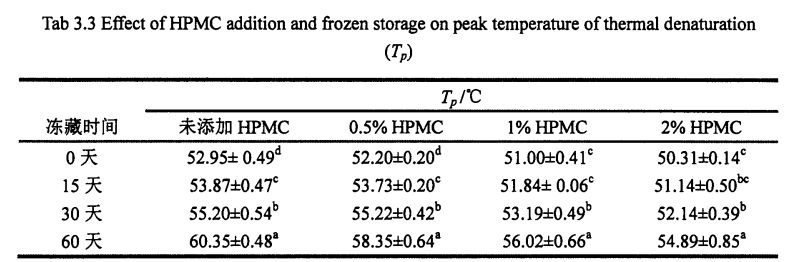
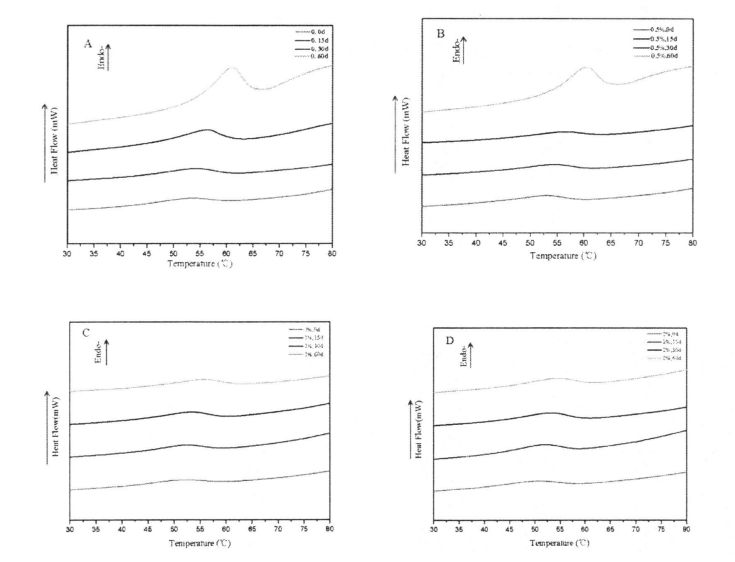
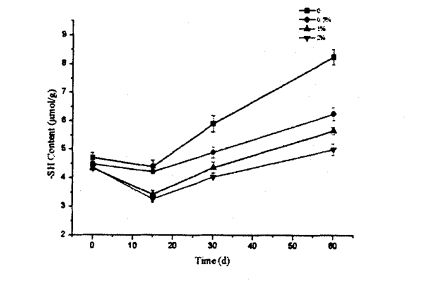
एचएमपीएमईसी थप एचपीएमसी थप र ग्र्याएमईसी थप र फ्रिज भण्डारणको सामग्री माथि उल्लेख गरिएको रूपमा नि: शुल्क भण्डारणको सामग्री कम तापक्रममा आइस क्रिस्टल गर्न र ग्र्याट नेटवर्कको अन्तरपालिकामा वितरण गर्न सक्दछ। Therefore, with the prolongation of freezing time, the ice crystals become larger, which squeezes the gluten protein structure more seriously, and leads to the breakage of some intermolecular and intramolecular disulfide bonds, which increases the content of free sulfhydryl groups. अर्कोतर्फ, प्रयोगात्मक परिणामहरूले देखाउँदछ कि एचपीएमसीले आइस क्रिस्टलहरूको दुर्बल क्षतिबाट विनाशकारी जीतलाई जोगाउन सक्छ, जसले गर्दा ग्लोटीन प्रोटीनको डिपोरेक्ट्रुटिनिटिसन प्रक्रिया रोक्दछ। 1.3..4 प्रभावहरू HPMC थप रकम र ट्रान्सभर्सर्स शुरुवात समय (T2) ट्रान्सभर्सर्स रिचार्श समय (T2) को लागी पानी माइग्रेनको वितरण र गतिशील प्रक्रियाको गतिशील प्रक्रिया प्रतिबिम्बित गर्न सक्दछ। Figure 3.4 shows the distribution of wet gluten mass at 0 and 60 days with different HPMC additions, including 4 main distribution intervals, namely 0.1.1 ms (T21), 1.10 ms (T22), 10.100 ms (dead;) and 1 00-1 000 ms (T24). Bosmans et al. (2012) found a similar distribution of wet gluten mass [1261], and they suggested that protons with relaxation times below 10 ms could be classified as rapidly relaxing protons, which are mainly derived from poor mobility the bound water, therefore, may characterize the relaxation time distribution of bound water bound to a small amount of starch, while Dang may characterize the relaxation time distribution of bound water bound to gluten protein. In addition, Kontogiorgos (2007) - t11¨, the "strands" of the gluten protein network structure are composed of several layers (Sheets) about 5 nm apart, and the water contained in these layers is limited water (or Bulk water, phase water), the mobility of this water is between the mobility of bound water and free water. And T23 can be attributed to the relaxation time distribution of restricted water. The T24 distribution (>100 ms) has a long relaxation time, so it characterizes free water with strong mobility. This water exists in the pores of the network structure, and there is only a weak capillary force with the gluten protein system.

यद्यपि भिजेको ग्लुटनको ट्वान्टाइनको उचाई र टी 23 वितरणको क्षेत्रमा स्पष्ट भिन्नताहरू थिए जुन विभिन्न HPMC थपिएका थिएनन् र थप, t23 वितरणको क्षेत्र वृद्धि भयो (चित्र 4.4)। This change shows that HPMC can significantly increase the relative content of limited water, and it is positively correlated with the added amount within a certain range. In addition, with the extension of freezing storage time, the height and area of T23 distribution of the wet gluten mass with the same HPMC content decreased to varying degrees. Therefore, compared with bound water, limited water showed a certain effect on freezing storage. Sensitivity. This trend suggests that the interaction between the gluten protein matrix and the confined water becomes weaker. यो हुन सक्छ किनभने अधिक हाइड्रोफोनबिक समूहहरू फ्रिजि on को समयमा उजागर हुन्छन्, जुन थर्मल विनाश शिखर तालिका मापनसँग अनुरूप छ। In particular, the height and area of the T23 distribution for the wet gluten mass with 2% HPMC addition did not show a significant difference. This indicates that HPMC can limit the migration and redistribution of water, and can inhibit the transformation of the water state from the restricted state to the free state during the freezing process.
In addition, the height and area of the T24 distribution of the wet gluten mass with different contents of HPMC were significantly different (Fig. 3.4, A), and the relative content of free water was negatively correlated with the amount of HPMC added. This is just the opposite of the Dang distribution. Therefore, this variation rule indicates that HPMC has water holding capacity and converts free water to confined water. यद्यपि, fight0 दिन पछि फ्रिजि of को उमेर पछि, T24 वितरणको उचाई र क्षेत्र बिभिन्न डिग्रीमा वृद्धि भयो, जसले फ्रिजिंग प्रक्रियाको बेला मात्र पानी राज्य परिवर्तन भएको छ। यो मुख्यतया Gowutn प्रोटीन अनुरूप र ग्लुटन संरचना मा "तह" एकाई को परिवर्तन को कारण छ, जसले सीमित पानीको राज्य परिवर्तन गर्दछ। Although the content of freezable water determined by DSC also increases with the extension of freezing storage time, however, due to the difference in the measurement methods and characterization principles of the two, the freezable water and free water are not completely equivalent. For the wet gluten mass added with 2% HPMC, after 60 days of freezing storage, none of the four distributions showed significant differences, indicating that HPMC can effectively retain the water state due to its own water-holding properties and its interaction with gluten. and stable liquidity.
Generally speaking, the secondary structure of protein is divided into four types, α-Spiral, β-folded, β-Corners and random curls. The most important secondary bonds for the formation and stabilization of the spatial conformation of proteins are hydrogen bonds. तसर्थ, प्रोटीन प्रसारण हाइड्रोजन बन्ड ब्रेक र संरचनात्मक परिवर्तनको प्रक्रिया हो।
Fourier transform infrared spectroscopy (FT-IR) has been widely used for high-throughput determination of the secondary structure of protein samples. प्रोटीनको इन्फ्रारेड स्पेक्ट्रममा विशेषता ब्यान्डमा मुख्य रूपमा समावेश गर्नुहोस्, AMAME समावेश गर्नुहोस् (10000.100 सेन्टीमिटर) र AMI ब्यान्ड (1 15500 सेमी ब्यान्ड)। Correspondingly, the amide I band the absorption peak originates from the stretching vibration of the carbonyl group (-C=O-.), the amide II band is mainly due to the bending vibration of the amino group (-NH-) [1271], and the amide III band is mainly due to the amino bending vibration and .CN-.Synchronous compound vibration in the same plane of bond stretching vibration, and has a high sensitivity to changes in protein secondary structure [128'1291. Although the above three characteristic bands are all characteristic infrared absorption peaks of proteins, the specific In other words, the absorption intensity of amide II band is lower, so the semi-quantitative accuracy of protein secondary structure is poor; पीक शोषणले अन्डरलाई अन्डर अफ अफ क्रप उच्च छ, त्यसैले धेरै अनुसन्धानकर्ताहरूले यस ब्यान्डको शोषणको रमरी र एन्डएमएमलाई बढावा दिएका छन्। 1 wavenumber (Overlapped), which in turn affects the accuracy of the results. Therefore, the interference of water limits the determination of the amide I band in protein secondary structure determination. In this experiment, in order to avoid the interference of water, the relative contents of four secondary structures of gluten protein were obtained by analyzing the amide III band. Peak position (wavenumber interval) of

Figure 3.5 is the infrared spectrum of the amide III band of gluten protein added with different contents of HPMC for 0 days after being frozen for 0 days after deconvolution and fitting of the second derivative. (2001) ले दोस्रो व्युत्पन्न चुचुरोलाई समान शिखर आकारहरूको साथ उपयुक्त चुचुराहरू फिट गर्न [1222]। प्रत्येक माध्यमिक संरचनाको सापेक्ष सामग्री परिवर्तनको मात्रामा, तालिका 3.5। ग्लेडीन प्रोटीनको बाँकी चार माध्यमिक संरचनाहरूको सापेक्ष प्रतिशत सामग्री र सम्बन्धित शिखर समायोजन क्षेत्र / शिखर कुल क्षेत्र)।
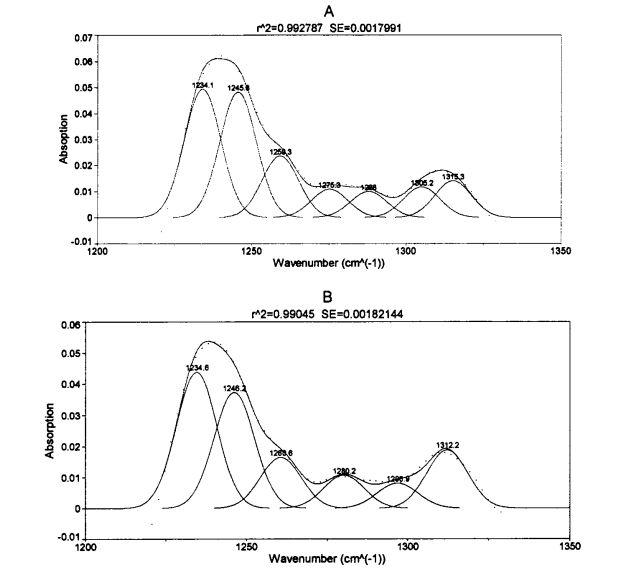
नोट: गहुँ ग्लोरा ग्लोट प्रोसेक्ट्रम हो जसमा एचपीएमसी थप्न बिना frolzen भण्डारणको 0 दिनको लागि एचपीएमसी थप्नुहोस्; B गहुँको गहुँको गहुँको गहुँको गहुँको गहुँको गुटन प्रोटीनको लागि 2% एचपीएमसीले थपिएको छ
With the prolongation of frozen storage time, the secondary structure of gluten protein with different additions of HPMC changed to different degrees. It can be seen that both frozen storage and addition of HPMC have an effect on the secondary structure of gluten protein. Regardless of the amount of HPMC added, B. The folded structure is the most dominant structure, accounting for about 60%. After 60 days of frozen storage, add 0%, OB Gluten of 5% and 1% HPMC. क्रमशः 3..66%, 1.6666%, 1.8666%, 1.867% र 1.1 resport% द्वारा क्रमशः बढेको छ, जुन मेजियाली एट अल द्वारा निर्धारित नतीजाहरूसँग मिल्दोजुल्दो थियो। (2011) [l33J]. However, there was no significant difference during frozen storage for gluten supplemented with 2% HPMC. In addition, when frozen for 0 days, with the increase of HPMC addition, p. The relative content of folds increased slightly, especially when the addition amount was 2%, p. The relative content of folds increased by 2.01%. D. The folded structure can be divided into intermolecular p. Folding (caused by aggregation of protein molecules), antiparallel p. Folded and parallel p. Three substructures are folded, and it is difficult to determine which substructure occurs during the freezing process
changed. Some researchers believe that the increase in the relative content of the B-type structure will lead to an increase in the rigidity and hydrophobicity of the steric conformation [41], and other researchers believe that p. फोल्ड गरिएको संरचनामा वृद्धि नयाँ β-फोउन गठनको अंशको कारण हो हाइड्रोजन बन्डरबाट संरचनात्मक बन्धन [421] द्वारा राखेको संरचनात्मक शक्तिको कारणले हो। β- राखिएको संरचना मा बढ्दो वृद्धिले संकेत गर्दछ कि प्रोटीन हाइड्रोफोबिक बन्धन मार्फत बहुमूल्य छ र कम क्षेत्रको आणविक चुनेकी अनुनाद द्वारा मापन गरिएको छ। Protein denaturation. On the other hand, added 0.5%, 1% and 2% HPMC gluten protein α-whirling. The relative content of helix increased by 0.95%, 4.42% and 2.03% respectively with the prolongation of freezing time, which is consistent with Wang, et a1. (2014) found similar results [134]. 0 of gluten without added HPMC. There was no significant change in the relative content of helix during the frozen storage process, but with the increase of the addition amount of freeze for 0 days. There were significant differences in the relative content of α-whirling structures.
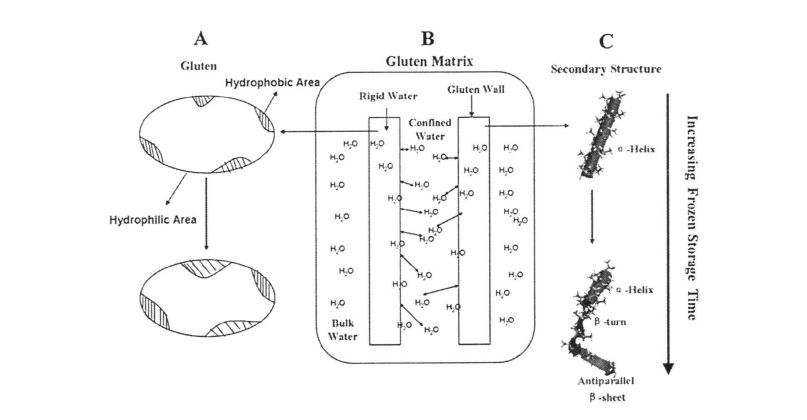
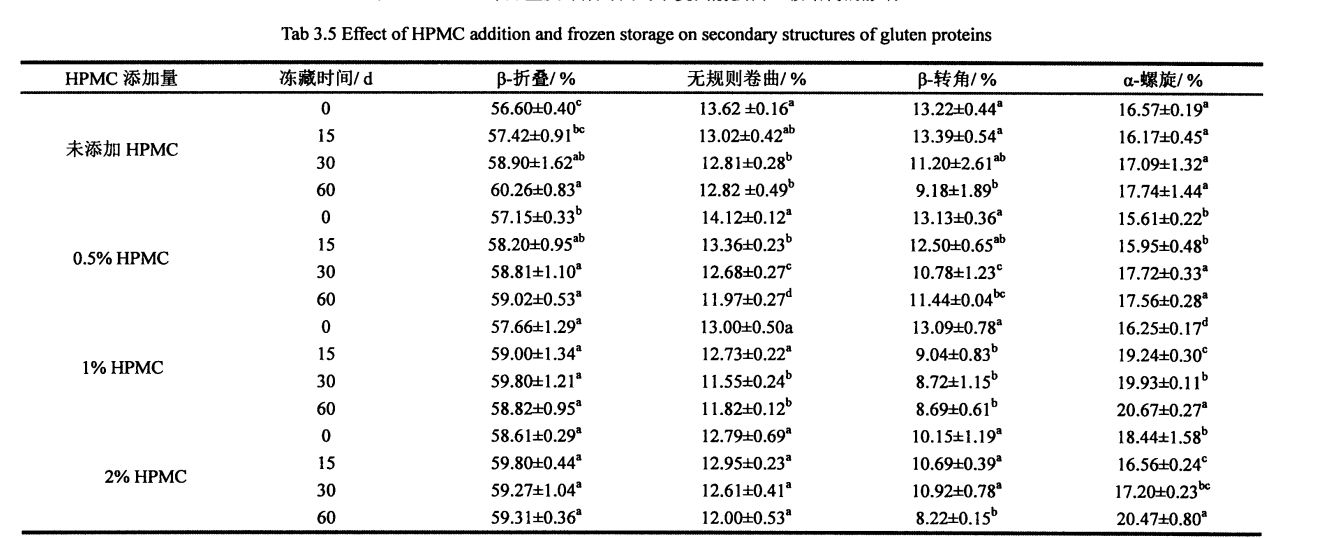
All samples with the extension of freezing time, p. The relative contents of the corners were significantly reduced. This shows that β-turn is very sensitive to freezing treatment [135. 1361], and whether HPMC is added or not has no effect. Wellner, et a1. (2005) proposed that the β-chain turn of gluten protein is related to the β-turn space domain structure of the glutenin polypeptide chain [l 37]. Except that the relative content of random coil structure of gluten protein added with 2% HPMC had no significant change in frozen storage, the other samples were significantly reduced, which may be caused by the extrusion of ice crystals. थप रूपमा, कहिले 0 दिनको लागि स्थिर, β-Helix, β-Helsir र βl-पाना र β ग्लेट-फेर्ड प्रोटीन संरचना 2% एचपीएमसीको साथ थपियो। यसले संकेत गर्न सक्दछ कि एचपीएमसी र ग्लुटन प्रोटिन बीचको अन्तर्क्रिया छ, नयाँ हाइड्रोजन बन्ड गठन गरी प्रोटीनको कन्फर्मेसनलाई असर गर्ने; वा HPMC प्रोटीन स्पेस संरचनाको खच्चर गुहामा पानी अवशोषित गर्दछ, जसले प्रोटिन लोट गर्दछ र उपनरा बीच बढी परिवर्तन गर्दछ। close. Β-पाना संरचनाको सापेक्ष सामग्रीको बृद्धि र β-पालो र α-Helix संरचनाको तुलनामा माथिको अनुमानसँग अनुरूप छ। During the freezing process, the diffusion and migration of water and the formation of ice crystals destroy the hydrogen bonds that maintain the conformational stability and expose the hydrophobic groups of proteins. In addition, from the perspective of energy, the smaller the energy of the protein, the more stable it is. At low temperature, the self-organization behavior (folding and unfolding) of protein molecules proceeds spontaneously and leads to conformational changes.
अन्तमा, जब एचपीएमसीको उच्च सामग्री थपिएको छ र प्रोटीनसँगको यो अन्तर्क्रियाको कारण एचपीएमसीले फ्रिन्ज प्रक्रियाको क्रममा ग्लुटेन प्रोटीनको माध्यमिक संरचनाको परिवर्तनलाई रोक्दछ।
Protein molecules include both hydrophilic and hydrophobic groups. Generally, the protein surface is composed of hydrophilic groups, which can bind water through hydrogen bonding to form a hydration layer to prevent protein molecules from agglomerating and maintain their conformational stability. प्रोटीनको भित्री भागमा हाइड्रोफोबिक बल मार्फत प्रोटीनको माध्यमिक र तेयरिचर संरचनाको लागि अधिक हाइड्रोफिक समूहहरू समावेश गर्दछ। Denaturation of proteins is often accompanied by exposure of hydrophobic groups and increased surface hydrophobicity.

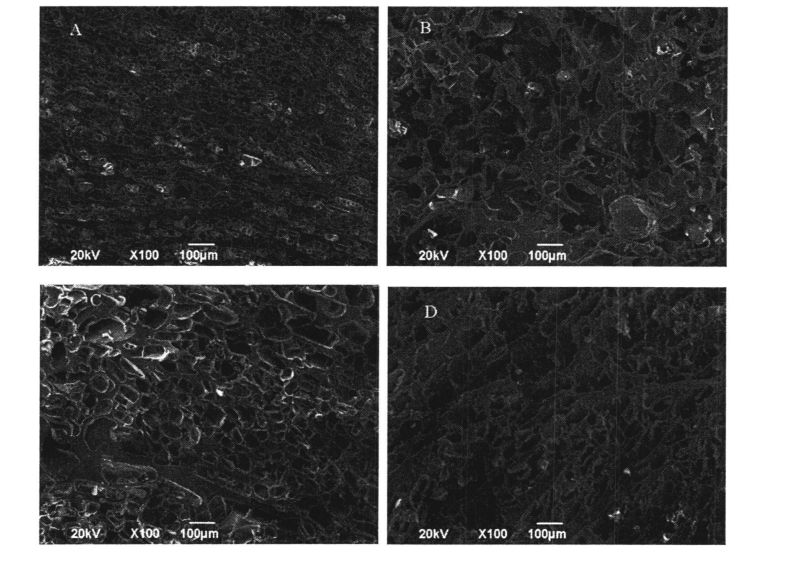
This experiment investigated the rheology of wet gluten dough and gluten protein by adding HPMC with different contents (0%, 0.5%, 1% and 2%) during freezing storage (0, 15, 30 and 60 days). properties, thermodynamic properties, and effects of physicochemical properties. The study found that the change and redistribution of water state during the freezing storage process significantly increased the freezable water content in the wet gluten system, which led to the destruction of the gluten structure due to the formation and growth of ice crystals, and ultimately caused the processing properties of the dough to be different. Deterioration of product quality. The results of frequency scanning showed that the elastic modulus and viscous modulus of the wet gluten mass without adding HPMC decreased significantly during the freezing storage process, and the scanning electron microscope showed that its microstructure was damaged. नि: शुल्क सल्फिड्रिल समूहको सामग्रीमा उल्लेखनीय बढेको थियो, र यसको जलविद्युत समूह बढी पर्दाफास भयो, जसले थर्मल डिशेशन तापमान तापमान लगायो र ग्लेटन प्रोटीनको सतह हाइड्रोफेक्टेसनलाई महत्त्वपूर्ण वृद्धि गर्यो। However, the experimental results show that the addition of I-IPMC can effectively inhibit the changes in the structure and properties of wet gluten mass and gluten protein during freezing storage, and within a certain range, this inhibitory effect is positively correlated with the addition of HPMC. यो किनभने HPMCले पानीको गतिशीलता कम गर्न र स्थिर पानीको मात्रा घटाउन सक्दछ, जसले गर्दा, जसले गर्दा, जसले गर्दा तालिमेटललाइजेशन घटनाहरू र प्रोटीन रूपमा स्थिरताको स्थानान्तरणको अनुरूप। This shows that the addition of HPMC can effectively maintain the integrity of the frozen dough structure, thereby ensuring product quality.
Starch is a chain polysaccharide with glucose as the monomer. key) two types. From a microscopic point of view, starch is usually granular, and the particle size of wheat starch is mainly distributed in two ranges of 2-10 pro (B starch) and 25-35 pm (A starch). क्रिस्टल संरचनाको परिप्रेक्ष्यबाट, स्टार्च ग्रानोल्समा क्रिस्टल क्षेत्रहरू र एमोरफेस क्षेत्रहरू (जे, गैर-क्रिस्टल क्षेत्रहरू) समावेश छन् (क्रिस्टल फारमहरू (यो पूर्ण जिलेटिनिजेशन पछि विभाजन हुन्छ)। Generally, the crystalline region consists of amylopectin and the amorphous region consists mainly of amylose. This is because, in addition to the C chain (main chain), amylopectin also has side chains composed of B (Branch Chain) and C (Carbon Chain) chains, which makes amylopectin appear "tree-like" in raw starch. The shape of the crystallite bundle is arranged in a certain way to form a crystal.
स्टार्च पीठोको मुख्य अंश हो, र यसको सामग्री लगभग% 75% (सुख्खा आधार) हो। At the same time, as a carbohydrate widely present in grains, starch is also the main energy source material in food. In the dough system, starch is mostly distributed and attached to the network structure of gluten protein. During processing and storage, starches often undergo gelatinization and aging stages.
Many studies have shown that the gel strength of starch paste decreases, it is easy to age, and its quality deteriorates under the condition of freezing storage, such as Canet, et a1. (2005) studied the effect of freezing temperature on the quality of potato starch puree; Ferrero, et a1. (1993) investigated the effects of freezing rate and different types of additives on the properties of wheat and corn starch pastes [151-156]. However, there are relatively few reports on the effect of frozen storage on the structure and properties of starch granules (native starch), which needs to be further explored. Frozen dough (excluding pre-cooked frozen dough) is in the form of ungelatinized granules under the condition of frozen storage. तसर्थ, एचपीएमसीलाई थपेर नेतृक पोर्चकको संरचना र संरचनात्मक परिवर्तनहरू स्थिर आटाको प्रशोधन सम्पत्ति सुधार गर्न निश्चित प्रभाव पार्दछ। significance.
Wheat Starch Binzhou Zhongyu Food Co., Ltd.; HPMC अलाडिन (शंघाई) रासायनिक रेजेन्ट कम्पनी, LTD ;;
BCD-201 TATTT फ्रिज
SX2..4.10 Muchle भट्टी
Q. 200 भन्दा फरक स्क्यान गर्दै क्यालोराइमेटर
SX2..4.10 Muchle भट्टी
उत्पादक
हेयर समूह
हेफेई मेलिंग कण, लिमिटेड।
अमेरिकी टी कम्पनी
अमेरिकी टी कम्पनी
Rigaua निर्माण कम्पनी, लिमिटेड।
2.2..3 प्रश चिकित्सा विधि
2.2..3.11 तयारी र स्थिर भण्डारण भण्डारण
(1) स्टार्च जिलागि विशेषताहरू
नमूना समाधानको 1. 1.5 मिलि clo कोर्नुहोस् र रेनोमीनेमी नमूना चरणको बीचमा हेर्नुहोस् माथिको प्रोग्राम को जलन गुणहरू मापन गर्नुहोस्, र समय (PS) (PO) को रूपमा सेट गर्नुहोस्। According to GB/T 14490.2008 [158], the corresponding gelatinization characteristic indicators—gelatinization peak viscosity (field), peak temperature (Ang), minimum viscosity (high), final viscosity (ratio) and decay value (Breakdown) are obtained. Value, BV) and regeneration value (Setback Value, SV), wherein, decay value = peak viscosity - minimum viscosity; setback value = final viscosity - minimum viscosity. Each sample was repeated three times.
(2) स्टार्च पेस्टको स्थिर प्रवाह परीक्षण
After the corresponding freezing treatment time, the samples were taken out, thawed completely, and dried in an oven at 40 °C for 48 h. Finally, it was ground through a 100-mesh sieve to obtain a solid powder sample for use (suitable for XRD testing). See Xie, et a1. (201 2014) नमूना तयारी र थर्मोडायनामिक सम्पत्तीहरूको दृढ संकल्पको लागि विधि अल्ट्रा एटरेटियल ब्याट्रीमा 10 मिटर स्टार्ट नमूनाको तौल 2 24 ° c मा 1 ° सेन्टिजमा राख्नुहोस्। Freeze at 18°C (0, 15, 30 and 60 days). Add 0.5%, 1%, 2% (w/w) HPMC to replace the corresponding quality of starch, and other preparation methods remain unchanged. After the freezing storage time is over, take out the crucible and equilibrate at 4 °C for 4 h.
एक सन्दर्भको रूपमा रिक्त क्रूरता लिदै, नाइट्रोजन प्रवाह दर min मिनेट 20 डिग्री सेल्सियसमा min0 डिग्री सेल्सिलिब्रेट गरिएको थियो, र त्यसपछि 100 डिग्री सेल्सियसलाई ° ° c / मिनेटमा तातो। Finally, the heat flow (Heat Flow, mW) is the DSC curve of the ordinate, and the gelatinization peak was integrated and analyzed by Universal Analysis 2000. Each sample was repeated at least three times.

Table 4.2 lists the influence of several important indicators of starch gelatinization characteristics, including gelatinization peak viscosity, minimum viscosity, final viscosity, decay value and appreciation value, and reflects the effect of HPMC addition and freezing time on starch paste. effects of chemical properties. प्रयोगात्मक परिणामहरूले देखाउँदछ कि पीक अनन्तता, स्टार्ट भण्डारण र स्थिर भण्डारण बिना स्थिर भण्डारको अन्तिम ज्यादै फ्रिज भण्डारणको अन्तिम हिसाबले बढेको छ, जबकि क्षय मूल्य र रिकभरी मान उल्लेखनीय रूपमा कम भयो। विशेष रूपमा, पीक आइतसाथी 7276.66.66 + 90.700 सीपीई (09.7575454545 ch2 CPMC) सम्बोधन गर्दै (1..63.63.63.6374.73737373748 CPMC) थपे। the minimum viscosity was increased from 391.02+18.97 CP (blank not adding) to 454.95+36.90 (adding O .5% HPMC), 485.56+54.0.5 (add 1% HPMC) and 553.03+55.57 CP (add 2% HPMC); the final viscosity is from 794.62.412.84 CP ( Without adding HPMC) increased to 882.24±22.40 CP (adding 0.5% HPMC), 846.04+12.66 CP (adding 1% HPMC) and 910.884-34.57 CP (adding 2 %HPMC); however, the attenuation value gradually decreased from 336.644-71.73 CP (without adding HPMC) to 303.564-11.22 CP (adding 0.5% HPMC), 324.19±2.54 CP (Add
अर्कोतर्फ, जब एचपीएमसीको रकम पनि त्यस्तै भयो, चरम अनन्त, न्यूनतम ज्याष्टता, न्यूनतम ज्याष्टता, स्टार्च जिलेटिनिटेशनको विस्तारको कारण स्टार्च जिस्कोकरणको दायरा र व्यवहारको दायरा र व्यवहारको दायरा र व्यवहारको दायरा र व्यवहारको दायरा र व्यवहारको दायरा र व्यवहारको दायराग्राफेशन मान लगातार बढेको छ। Specifically, the peak viscosity of starch suspension without adding HPMC increased from 727.66±90.70 CP (frozen storage for 0 days) to 1584.44+68.11 CP (frozen storage for 60 days); adding 0.5 The peak viscosity of starch suspension with %HPMC increased from 758.514-48.12 CP (freezing for 0 days) to 1415.834-45.77 CP (freezing for 60 days); starch suspension with 1% HPMC added The peak viscosity of the starch liquid increased from 809.754-56.59 CP (freeze storage for 0 days) to 1298.19-±78.13 CP (frozen storage for 60 days); while the starch suspension with 2% HPMC CP added Gelatinization peak viscosity from 946.64 ± 9.63 CP (0 days frozen) increased to 1240.224-94.06 CP (60 days frozen). At the same time, the lowest viscosity of starch suspension without HPMC was increased from 391.02-41 8.97 CP (freezing for 0 days) to 556.77±29.39 CP (freezing for 60 days); adding 0.5 The minimum viscosity of the starch suspension with %HPMC increased from 454.954-36.90 CP (freezing for 0 days) to 581.934-72.22 CP (freezing for 60 days); the starch suspension with 1% HPMC added The minimum viscosity of the liquid increased from 485.564-54.05 CP (freezing for 0 days) to 625.484-67.17 CP (freezing for 60 days); while the starch suspension added 2% HPMC CP gelatinized The lowest viscosity increased from 553.034-55.57 CP (0 days frozen) to 682.58 ± 20.29 CP (60 days frozen).
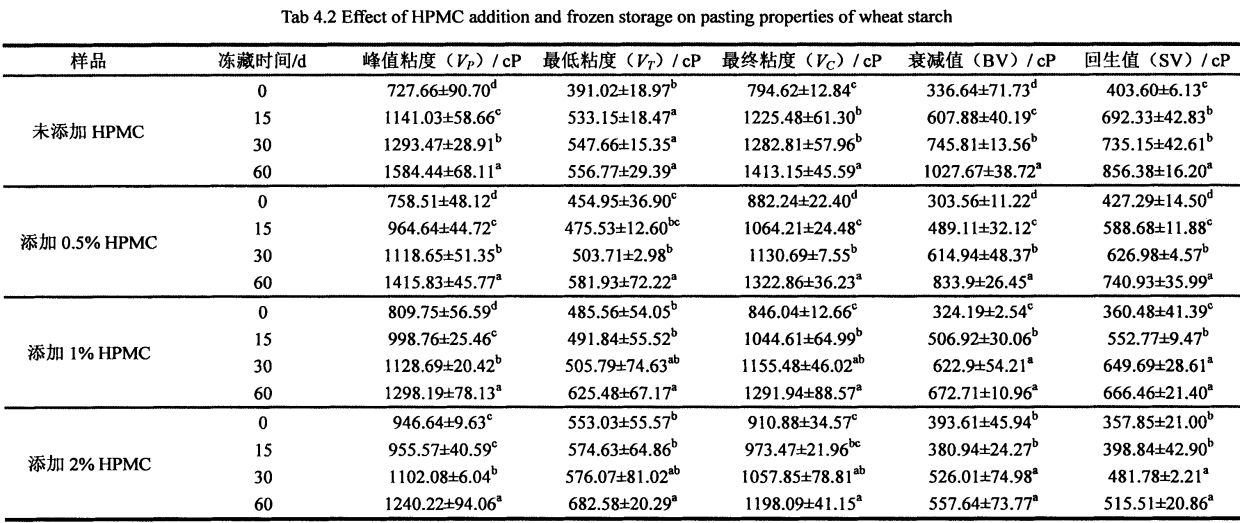
(Frozen storage for 0 days) increased to 1198.09 ± 41.15 CP (frozen storage for 60 days). संगतै, स्टार्च निलम्बन निलम्बन निलम्बन निलम्बन निलम्बनको मूल्य 33 336.74 ± 71.7373 CP को लागी 1027.7373774772 CP (days0 दिनसम्म)। adding 0.5 The attenuation value of starch suspension with %HPMC increased from 303.56±11.22 CP (frozen storage for 0 days) to 833.9±26.45 CP (frozen storage for 60 days); starch suspension with 1% HPMC added The attenuation value of the liquid was increased from 324.19 ± 2.54 CP (freezing for 0 days) to 672.71 ± 10.96 CP (freezing for 60 days); while adding 2% HPMC,the attenuation value of the starch suspension increased from 393.61 ± 45.94 CP (freezing for 0 days) to 557.64 ± 73.77 CP (freezing for 60 days); while the starch suspension without HPMC added The retrogradation value increased from 403.60 ± 6.13 C
It can be seen that with the prolongation of freezing storage time, the starch gelatinization characteristics index increased, which is consistent with Tao et a1. F2015) 1। प्रयोगात्मक नतीजासँग मिलेर, फ्रिज-फिग चरमको संख्या, स्टार्च जिलागी, क्षारीदात्व, र स्टार्च GEPRESSSSSSSESSES [166.S मा सबै डिग्रीहरू [166. This is mainly because in the process of freezing storage, the amorphous region (Amorphous Region) of starch granules is destroyed by ice crystallization, so that the amylose (the main component) in the amorphous region (non-crystalline region) undergoes phase separation (Phase. separated) phenomenon, and dispersed in the starch suspension, resulting in an increase in the viscosity of starch gelatinization, and an increase in the related attenuation value and retrogradation value. However, the addition of HPMC inhibited the effect of ice crystallization on starch structure. Therefore, the peak viscosity, minimum viscosity, final viscosity, decay value and retrogradation rate of starch gelatinization increased with the addition of HPMC during frozen storage. increase and decrease sequentially.



(Thixotropic Loop) area, which is similar to Temsiripong, et a1. (2005) reported the same conclusion [167]. This may be mainly because HPMC can form intermolecular cross-links with gelatinized starch chains (mainly amylose chains), which "bound" the separation of amylose and amylopectin under the action of shearing force. , ताकि संरचनाको स्थिरता र संरचनाको एकरूपता (चित्र 2.2, विक्रेता दरका साथ वक्र र आदेशको रूपमा कर्भरको वक्र कायम राख्न)।
However, with the prolongation of freezing storage time, the values of K and n increased to different degrees, among which the value of K increased from 78.240 ± 1.661 Pa·sn (unadded, 0 days) to 95.570 ± 1, respectively. 2.421 Pa·sn (no addition, 60 days), increased from 65.683±1.035 Pa ·S n (addition of O. 5% HPMC, 0 days) to 51.384±1.350 Pa ·S n (Add to 0.5% HPMC, 60 days), increased from 43.122±1.047 Pa ·sn (adding 1% HPMC, 0 days) to 56.538±1.378 Pa ·sn (adding 1% HPMC, 60 days) ), and increased from 13.926 ± 0.330 Pa ·sn (adding 2% HPMC, 0 days) to 16.064 ± 0.465 Pa ·sn (adding 2% HPMC, 60 days); 0.277 ± 0.011 (without adding HPMC, 0 days) rose to O. 334±0.014 (no addition, 60 days), increased from 0.310±0.009 (0.5% HPMC added, 0 day) to 0.336±0.014 (0.5% HPMC added, 60 days), from 0.323 ± 0.013 (add 1% HPMC, 0 days) to 0.340 ± 0.013 (add 1% HPMC, 60 days), and from 0.431 ± 0.013 (add 1% HPMC, 60 days) 2% HPMC, 0 days) to 0.404+0.020 (add 2% HPMC, 60 days). By comparison, it can be found that with the increase of the addition amount of HPMC, the change rate of K and Knife value decreases successively, which shows that the addition of HPMC can make the starch paste stable under the action of shearing force, which is consistent with the measurement results of starch gelatinization characteristics. अनुरूप
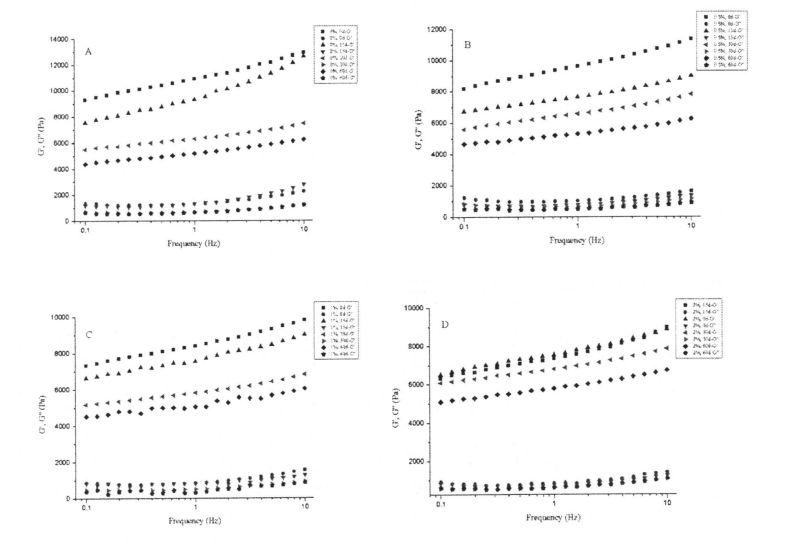
The starch gelatinization process is accompanied by the disintegration of starch granules, the disappearance of the crystalline region, and the hydrogen bonding between starch chains and moisture, the starch gelatinized to form a heat-induced (Heat. induced) gel with a certain gel strength. As shown in Figure 4.3, for starch without frozen storage, with the increase of HPMC addition, the G' of starch decreased significantly, while G" had no significant difference, and tan 6 increased (Liquid. 1ike), which shows that during the gelatinization process, HPMC interacts with starch, and due to the water retention of HPMC, the addition of HPMC reduces the water loss of starch during the gelatinization process. At the same time, Chaisawang & Suphantharika (2005) found that, adding guar gum and xanthan gum to tapioca starch, the G' of the starch paste also decreased [170]. In addition, with the extension of the freezing storage time, the G' of starch gelatinized decreased to different degrees. This is mainly because during the frozen storage process of starch, the amylose in the amorphous region of starch ग्रेन्यूलहरू बिग्रिएको स्टार्च (बिग्रिएको स्टार्च) गठन गर्न छुट्टिन्छ, जसले स्टार्ट जिलागि र क्रस-लिंक पछि क्रस-लिंग पछि क्रस-लिंक को डिग्री कम गर्दछ। स्थिरता र कम्प्याक्ट्यूकरण, र बरफ क्रिस्टलहरूको शारीरिक बाहिरी भागले स्टार्च क्रिस्टिभलिस्टिक स्टार्टको तुलनामा आणविक जलवित्वको अपर्याप्त संयोजन, र अन्ततः आणविक जलप्रलयको अपर्याप्त संयोजनको परिणामस्वरूप, र अन्तमा gel strength of starch to decline. However, with the increase of HPMC addition, the decreasing trend of G' was suppressed, and this effect was positively correlated with the addition of HPMC. This indicated that the addition of HPMC could effectively inhibit the effect of ice crystals on the structure and properties of starch under frozen storage conditions.
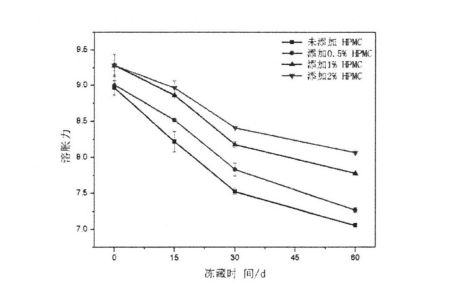

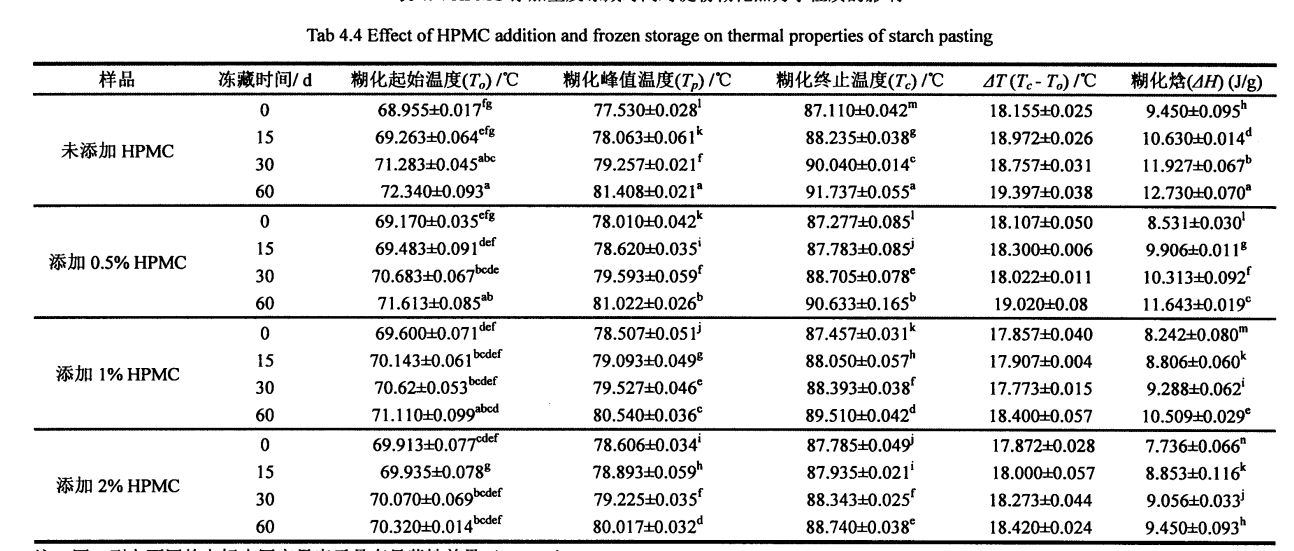
As shown in Table 4.4, for fresh amyloid, with the increase of HPMC addition, starch L has no significant difference, but increases significantly, from 77.530 ± 0.028 (without adding HPMC) to 78.010 ± 0.042 (add 0.5% HPMC), 78.507 ± 0.051 (add 1% HPMC), and 78.606 ± 0.034 (add 2% HPMC), but 4H is significant Decrease, from 9.450 ± 0.095 (without adding HPMC) to 8.53 ± 0.030 (adding 0.5% HPMC), 8.242A: 0.080 (adding 1% HPMC) and 7 .736 ± 0.066 (add 2% HPMC). यो zhou, et A1 जस्तै छ। (2008) found that adding a hydrophilic colloid decreased the starch gelatinization enthalpy and increased the starch gelatinization peak temperature [172]. This is mainly because HPMC has better hydrophilicity and is easier to combine with water than starch. At the same time, due to the large temperature range of the thermally accelerated gelation process of HPMC, the addition of HPMC increases the peak gelatinization temperature of starch, while the gelatinization Enthalpy decreases.
यद्यपि फ्रिजिंग भण्डारण समयको लामो समयसम्म स्टार्चको लामो समयसम्म क्रिस्टिवत्वको साथ 20..400 + 0.400400, 0 दिनसम्म) क्रमशः 46 36..522 0.42 (UPMC, स्थिर भण्डारण)। 60 days), and increased from 25.75 + 0.21 (2% HPMC added, 0 days) to 32.70 ± 0.14 (2% HPMC added, 60 days) (Figure 4.6.B), this and Tao, et a1. (2016), the change rules of the measurement results are consistent [173-174]. The increase in relative crystallinity is mainly caused by the destruction of the amorphous region and the increase in the crystallinity of the crystalline region. In addition, consistent with the conclusion of the changes in the thermodynamic properties of starch gelatinization, the addition of HPMC reduced the degree of relative crystallinity increase, which indicated that during the freezing process, HPMC could effectively inhibit the structural damage of starch by ice crystals and maintain the Its structure and properties are relatively stable.
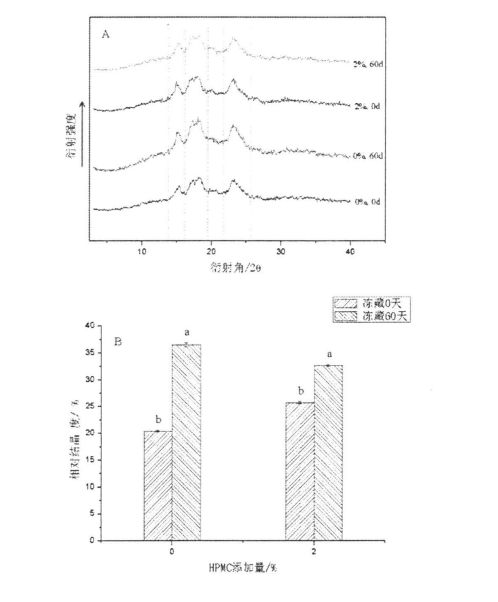
जल्लेटिनिजेशन पछि, ग्लेज पछि स्टार्च सबैभन्दा प्रशस्त सुख्खा पदार्थ हो, अद्वितीय गुणहरू (विशिष्ट भोल्युम, बनावट, र स्वाद, आदि) पीट उत्पादनमा। Since the change of starch structure will affect its gelatinization characteristics, which will also affect the quality of flour products, in this experiment, the gelatinization characteristics, flowability and flowability of starch after frozen storage were investigated by examining starch suspensions with different contents of HPMC added. Changes in rheological properties, thermodynamic properties and crystal structure were used to evaluate the protective effect of HPMC addition on starch granule structure and related properties. The experimental results showed that after 60 days of frozen storage, the starch gelatinization characteristics (peak viscosity, minimum viscosity, final viscosity, decay value and retrogradation value) all increased due to the significant increase in the relative crystallinity of starch and the increase in the content of damaged starch. The gelatinization enthalpy increased, while the gel strength of starch paste decreased significantly; however, especially the starch suspension added with 2% HPMC, the relative crystallinity increase and starch damage degree after freezing were lower than those in the control group Therefore, the addition of HPMC reduces the degree of changes in gelatinization characteristics, gelatinization enthalpy, and gel strength, which indicates that the addition of HPMC keeps the starch structure and its gelatinization properties relatively stable.
उत्पादक

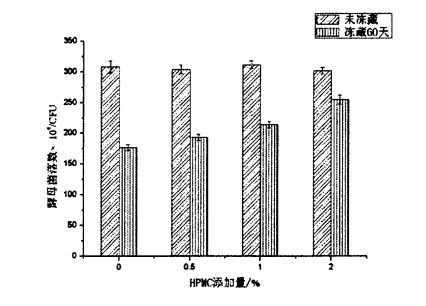
It can be seen from Figure 5.2 that there is no significant difference in the number of yeast colonies in samples with different contents of HPMC added without freezing treatment. This is similar to the result determined by Heitmann, Zannini, & Arendt (2015) [180]. जे होस्, फ्रिजिंगको days0 दिन पछि, खमीर उपनिवेशको संख्या .8.08x106 CFU मा 1.7674x106 CFU (HPMC थप्न बिना); from 3.04x106 CFU to 193x106 CFU (adding 0.5% HPMC); reduced from 3.12x106 CFU to 2.14x106 CFU (added 1% HPMC); reduced from 3.02x106 CFU to 2.55x106 CFU (added 2% HPMC). By comparison, it can be found that the freezing storage environment stress led to the decrease of the yeast colony number, but with the increase of HPMC addition, the degree of the decrease of the colony number decreased in turn. This indicates that HPMC can better protect yeast under freezing conditions. The mechanism of protection may be the same as that of glycerol, a commonly used strain antifreeze, mainly by inhibiting the formation and growth of ice crystals and reducing the stress of low temperature environment to yeast. Figure 5.3 is the photomicrograph taken from the 3M yeast rapid counting test piece after preparation and microscopic examination, which is in line with the external morphology of yeast.
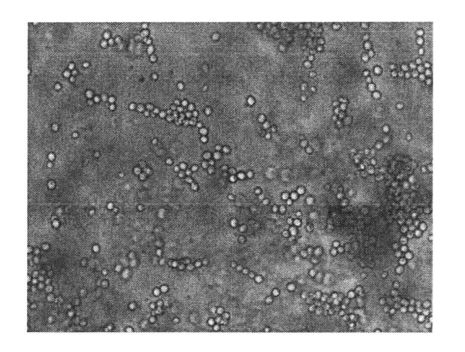
ग्लथथ्यान्स एक ट्रिपमिक एसिड, पार्थिब र गिलिनको बर्खास्त छ, र दुई प्रकारका छन्: कम र ऑक्सीकरण। When the yeast cell structure is destroyed and died, the permeability of the cells increases, and the intracellular glutathione is released to the outside of the cell, and it is reductive. यो विशेष गरी लायक छ कि ग्लिथथ रनले ग्लोट्याइड प्रोटीन (-S) ग्लोटन प्रोटीनको क्रस-बाइ-बनेको विजयी बन्ड-द्वारा गठन गर्दछ, जसले आटा नेटवर्क संरचनालाई असर गर्दछ। stability and integrity, and ultimately lead to the deterioration of the quality of fermented flour products. Usually, under environmental stress (such as low temperature, high temperature, high osmotic pressure, etc.), yeast will reduce its own metabolic activity and increase its stress resistance, or produce spores at the same time. When the environmental conditions are suitable for its growth and reproduction again, then restore the metabolism and proliferation vitality. However, some yeasts with poor stress resistance or strong metabolic activity will still die if they are kept in a frozen storage environment for a long time.
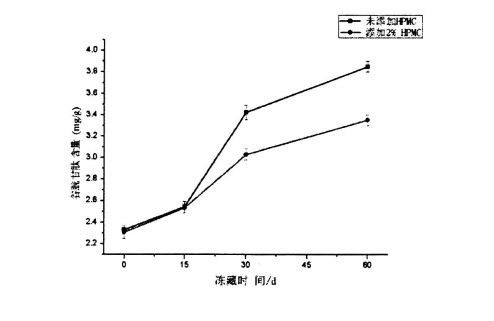
As shown in Figure 5.4, the glutathione content increased regardless of whether HPMC was added or not, and there was no significant difference between the different addition amounts. यो हुन सक्छ किनकि सक्रिय सुख्खा खमीरका केही पिठो तनाव प्रतिरोध र सहिष्णुता छ। Under the condition of low temperature freezing, the cells die, and then glutathione is released, which is only related to the characteristics of the yeast itself. It is related to the external environment, but has nothing to do with the amount of HPMC added. Therefore, the content of glutathione increased within 15 days of freezing and there was no significant difference between the two. However, with the further extension of the freezing time, the increase of glutathione content decreased with the increase of HPMC addition, and the glutathione content of the bacterial solution without HPMC was increased from 2.329a: 0.040mg/ g (frozen storage for 0 days) increased to 3.8514-0.051 mg/g (frozen storage for 60 days); while the yeast liquid added 2% HPMC, its glutathione content increased from 2.307+0 .058 mg/g (frozen storage for 0 days) rose to 3.351+0.051 mg/g (frozen storage for 60 days). This further indicated that HPMC could better protect yeast cells and reduce the death of yeast, thereby reducing the content of glutathione released to the outside of the cell. This is mainly because HPMC can reduce the number of ice crystals, thereby effectively reducing the stress of ice crystals to yeast and inhibiting the increase of extracellular release of glutathione.
पोष्ट समय: अक्टुबर-08-202222







